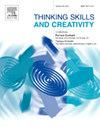科学胜任力对归纳推理与领域一般性和特定问题解决关系的中介作用
IF 4.5
2区 教育学
Q1 Social Sciences
引用次数: 0
摘要
本研究探讨了科学能力在归纳推理与问题解决之间的中介作用。为了全面了解问题解决机制,研究采用了复杂问题解决和科学问题解决两种类型的问题解决。参与者为 1232 名印度尼西亚高中生(年龄:16.79 岁;标准差:0.98;男生占 36.6%,女生占 63.4%)。研究使用 MicroDYN 测试来测量复杂问题解决(CPS)和科学问题解决(SPS)。其他工具是归纳推理(IR)和科学能力(SC)测试。结果表明,科学能力同时调解了IR与CPS和SPS之间的关系(β = 0.35, SE = 0.07, p < .001, CI(95 %) = [.24, 0.47]; β = 0.36, SE = 0.07, p < .01, CI(95 %) = [.26, 0.47])。我们的结论是,IR 在支持问题解决的动力方面具有相关性,而且它是由 SC 介导的。本文讨论了进一步研究的意义和建议。本文章由计算机程序翻译,如有差异,请以英文原文为准。
Mediation effect of scientific competency on relationship between inductive reasoning and domain-general and domain-specific problem solving
This study investigated the role of scientific competency in mediating the relationship between inductive reasoning and problem-solving. Two types of problem solving, complex problem solving and science problem solving, were used to understand problem-solving mechanisms comprehensively. The participants were 1232 Indonesian high school students (Mage = 16.79 years; SD = 0.98; 36.6 % boys and 63.4 % girls). The MicroDYN test was used to measure complex problem-solving (CPS) along with science problem-solving (SPS). The other instruments were the inductive reasoning (IR) and scientific competency (SC) tests. The results indicated that SC mediated the relationship between IR with CPS and SPS simultaneously (β = 0.35, SE = 0.07, p < .001, CI(95 %) = [.24, 0.47]; β = 0.36, SE = 0.07, p < .01, CI(95 %) = [.26, 0.47], respectively). Our conclusion is that IR is relevant in supporting the dynamics of problem-solving, and it is mediated by SC. Implications and recommendations for further research are discussed.
求助全文
通过发布文献求助,成功后即可免费获取论文全文。
去求助
来源期刊

Thinking Skills and Creativity
EDUCATION & EDUCATIONAL RESEARCH-
CiteScore
6.40
自引率
16.20%
发文量
172
审稿时长
76 days
期刊介绍:
Thinking Skills and Creativity is a new journal providing a peer-reviewed forum for communication and debate for the community of researchers interested in teaching for thinking and creativity. Papers may represent a variety of theoretical perspectives and methodological approaches and may relate to any age level in a diversity of settings: formal and informal, education and work-based.
 求助内容:
求助内容: 应助结果提醒方式:
应助结果提醒方式:


